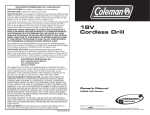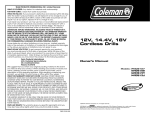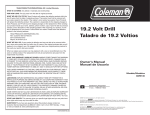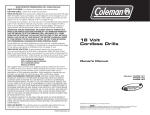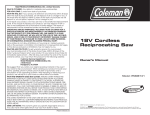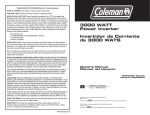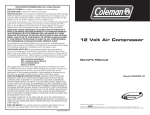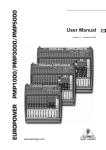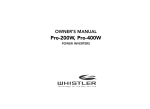Download Coleman PMP3000 Owner`s manual
Transcript
TEAM PRODUCTS INTERNATIONAL INC. Limited Warranty What is covered: Any defect in materials and workmanship. For how long: 2 years from date of purchase. What we will do: If your product is defective and returned within 30 days after the date it was purchased, we will replace it at no charge to you. If returned after 30 days but within 2 years of the date of purchase we will repair it or, at our option, replace it at no charge to you. If we repair your product, we may use new or reconditioned replacement parts. If we choose to replace your product, we may replace it with a new or reconditioned one of the same or similar design. The repair or replacement will be warranted under our standard 2 year warranty. LIMITATIONS: Implied warranties, including those of fitness for a particular purpose and merchantability (an unwritten warranty that the product is fit for ordinary use), are limited to 2 years from date of purchase. We will not pay for loss of time, inconvenience, loss of use of your product or property damage caused by your product or its failure to work, or any other incidental or consequential damages including personal injury. Some states do not allow limitations on how long an implied warranty lasts or the exclusion or limitation of incidental or consequential damages, so the above exclusions or limitations may not apply to you. What we ask you to do: To get warranty service for your product, you must provide proof of the date of purchase. Within 30 days of the date it was purchased, return your product to your place of purchase for immediate replacement. After 30 days, but before the end of the 2 year warranty period, you may return the product to the following address: TEAM PRODUCTS INTERNATIONAL INC. Attn: Customer Service Returns 35 A Continental Drive Wayne, NJ 07470 We suggest that you retain your original packing material in the event you need to ship your product. When sending your product include your name, address, phone number, proof of date of purchase, and a description of the operating problem. After repairing or replacing your product, we will ship it to your home or office within four weeks. What this warranty does not cover: Among other things this warranty does not cover defects resulting from accidents, damage while in transit to our service location, alterations, unauthorized repair, failure to follow instructions, misuse, fire, flood, and acts of God. If your product is not covered by our warranty, call our Customer Service number at (888) 231-4022 to determine whether we will repair your product and other repair information, including charges. We, at our option, may replace rather than repair your product with a new or reconditioned one of the same or similar design. The repair or replacement will be warranted for 2 years. This limited warranty is the only one we give on your product, and it sets forth all our responsibilities regarding your product. There are no warranties which extend beyond the description set forth above. State Law Rights: This warranty gives you specific legal rights and you may also have other rights which may vary from state to state. PMP3000033106-82 3000 WATT Power Inverter Owner’s Manual PMP3000 Models ©2006 The Coleman Company, Inc. All rights reserved. COLEMAN® and are registered trademarks of The Coleman Company, Inc., used under license. Designed in the USA and custom-manufactured in China for Team Products International Inc. Distributed by Team Products International Inc., Mountain Lakes, NJ 07046. Owner’s Manual PMP3000 Models Rear Panel Welcome This COLEMAN® product has been carefully engineered and manufactured to give you dependable operation. Please read this manual thoroughly before operating your new COLEMAN® product, as it contains the information you need to become familiar with its features and obtain the performance that will bring you continued enjoyment for many years. Please keep this manual on file for future reference. 10 7. Power Input Terminal Red = Positive 8. Power Input Terminal Black = Negative 9. Ground Lug Terminal 10. Cooling Fan How Power Inverters Work Power inverters convert low voltage DC (direct current) power to 120 volt AC (alternating current) household power. This conversion process thereby allows you to use household products, power tools, and other electronic products away from normal AC power sources (standard 120V wall outlets). Depending on the model and its rated capacity, inverters can draw power either from standard 12-volt automobile and marine batteries or from portable high power 12-volt power sources. The waveform that is generated by this conversion is a “modified sine wave”. The modified sine wave produced by our inverters has a root square mean (RMS) voltage of 120 volts, which is the same as standard household power. The majority of AC voltmeters are calibrated for RMS voltage under the assumption that the measured waveform will be a pure sine wave. Therefore, these meters will not read the RMS modified sine wave voltage correctly. They will read about 20 to 30 volts too low. To accurately measure the output voltage of the inverter, use a true RMS reading voltmeter such as a Fluke 87, Fluke 8060A, Beckman 4410, Triplett 4200 or any voltmeter identified as a “true RMS”. Controls and Components 9 8 CAUTION • The inverter is designed to operate from a 12-volt power source only. The unit will not operate from a 6-volt battery or a 24-volt battery. Do not attempt to connect the inverter to any other power source other than a battery with a nominal output voltage of 12 volts or damage to the unit may occur and will void the warranty. • 120 volts can inflict serious injury, damage or death. Improper use of the inverter may result in property damage, personal injury or loss of life. Getting Started When you turn on an appliance or tool that operates using a motor or a tube (such as a television), it requires an initial surge of power to start up. This surge of power is referred to as the “starting load” or “peak load”. Once started, the appliance or tool requires less power to continue to operate. This is referred to as the “continuous load”. You will need to determine how much power your appliance or tool requires to start up (peak power) and it’s continued operating power requirements (continuous load). Front Panel 1. LED Indicator Light (Green = Power ON, Red = Overload) 2. Remote Control Connection 7 5. Display Selector Switch Power consumption is rated in either wattage (watts) or amperes (amps). This information is usually stamped or printed on most appliances and equipment. If this information is not indicated on the actual product, check the owner’s manual or contact the manufacturer to determine the power consumption. Be sure that the power consumption of the item you wish to operate is rated at 3000 watts or less. 6. 120 Volt AC Outlets Multiply: AMPS x 120 (AC voltage) = WATTS 4 3. ON/OFF Power Switch 5 4. Digial Display This formula yields a close approximation of the continuous load of the appliance. 3 2 1 1 6 To determine whether the inverter will operate a particular item, run a test. All COLEMAN® inverters are designed to automatically shut down in the event of a power overload. This protection feature prevents damage to the unit while testing items with ratings in the 3000-watt range. 2 Owner’s Manual PMP3000 Models Connecting the Inverter Notes When connecting the inverter to the power source, it is recommended to use the thickest wire available in the shortest length possible. If the inverter and the battery are positioned within 4 feet of each other, a minimum of #0 gauge wire should be used to make the connections. When the distance between them is 4 to 6 feet, a minimum of #00 gauge wire is required. When separated by more than six feet, contact a qualified technician to determine the appropriate wire size to use given the distance between the inverter and the battery. • Loose connections can result in a severe decrease in voltage, which may cause damage to the component or the product you wish to operate. 1. Make sure the ON/OFF power switch located on the front panel of the inverter is in the OFF(O) position. 2. Loosen and remove the bolts and nuts from the red (+) and black (-) power input terminals. 3. It is recommended to use a crimped “loop style” connector on the ends of the cables when connecting the cables to the inverter. 4. Connect the cable wires to the power input terminals making sure to match the color coded cables to the color coded terminals on the inverter (RED= Positive, BLACK = Negative). Tighten the bolts and nuts to secure the cables. Be sure not to over tighten. Note: A secure connection is essential to proper operation of the inverter. Be certain to use the supplied bolts, nuts and washers included to connect the cables. 5. Connect the cable from the Positive (+) terminal (RED) on the inverter to the Positive terminal on the power source. Double check that the connection is secure. 6. Locate the Ground Lug Terminal at the rear of the inverter. Run a wire from this terminal to a proper grounding point using the shortest practical length. It is recommended to use a minimum of 12 AWG wire. You can connect this wire to the chassis of your vehicle or to the grounding system in your boat. As an alternative, when in remote locations the ground wire can be connected to the earth (one way to accomplish this is to attach the wire to a metal rod driven into the ground). Before connecting to the ground, make certain that the inverter is turned off. Operation the inverter without correctly grounding the unit may result in electrical shock. 7. Turn the inverter power switch to the ON(I) position. The LED Indicator Light should illuminate GREEN to confirm that power is running to the inverter. 8. Turn the inverter power switch to the OFF(O) position. (The LED Indicator Light may “blink” briefly and/or the internal audible alarm may make a momentary “chirp”. This is normal). • Failure to make a proper connection between the inverter and the power source may result in reverse polarity. Reverse polarity will blow the internal fuses in the inverter and may cause permanent damage to the inverter. Damage caused by reverse polarity is not covered under the warranty. • The audible alarm may make a momentary “chirp” when the inverter is turned ON(I) or OFF(O). This same alarm may also sound when the inverter is being connected to or disconnected from the 12-volt power source. This is normal. • If the LED Indicator Light blinks when you first turn the inverter ON(I), this may indicate an interruption of the power supply. Simply turn the inverter OFF(O) and try removing and reconnecting the clamps. If this does not fix the problem, try using a different 12-volt power source. • If using more than one appliance, do not exceed a combined total of 3000 watts. Source of Power Most automobile, truck and marine batteries will provide an ample power supply to the inverter for 30 to 60 minutes even when the engine is turned off. Actual time may vary depending on the age and condition of the battery and the power demand being placed on it by the equipment being operated. If you decide to use the inverter while the engine is off, we recommend that you start the engine every 30 to 60 minutes and let it run for approximately 10 minutes to recharge the battery. It is also recommended that the device plugged into the inverter be turned OFF before starting the vehicle engine. Although it is not necessary to disconnect the inverter when starting the vehicle engine, it may momentarily cease to operate as the battery voltage decreases. When the inverter is not supplying power, it draws very low amperage from the battery. It is recommend that the inverter always be disconnected when not in use. Note: Always disconnect the power inverter from the 12-volt power source and make sure the inverter is turned OFF before replacing the fuse. Safety and Usage Precautions 9. Make sure that the device you intend to operate is turned OFF. Plug the cord from the equipment you wish to operate into one of the AC outlets located on the front panel of the inverter. • For best operating results, place the inverter on a flat surface 10. Turn the inverter power switch to the ON(I) position. Then turn the equipment on. • DO NOT operate the inverter if you, the inverter, the device being operated, or any surface that may come into contact with the inverter are wet. Water and other liquids can conduct electricity, which may lead to serious injury or death. 3 • Keep inverter dry. Do not expose inverter to rain or moisture. 4 Owner’s Manual PMP3000 Models • Avoid placing the inverter on or near heating vents, radiators or other sources of heat. Do not place or use the inverter in direct sunlight. Ideal air temperatures should be between 50° and 80° F. • In order to properly disperse the heat generated from the inverter while it is operating, keep the inverter well ventilated. Keep the area surrounding the inverter clear while in use. • Do not use the inverter near flammable materials. Do not place the inverter in areas such as battery compartments where fumes or gases may accumulate. Inverter Protection Features • Short Circuit Protection. The inverter will automatically shut down until short is removed. • Low Voltage Alarm. An alarm will sound when the voltage from the battery discharges to 10.5 +/- 0.5 volts DC. This is an indication that the battery needs to be recharged. • Over Voltage Protection. The RED LED Indicator Light will illuminate and the inverter will automatically turn itself off when the input exceeds 16.5 +/- 1 volt DC. • Under Voltage Protection. The RED LED Indicator Light will illuminate and the inverter will automatically turn itself off when the input is less than 10.0 +/- 0.5 volts DC. • Overload Protection. The RED LED Indicator Light will illuminate and the inverter will automatically turn itself off when the continuous draw of the equipment being operated exceeds 3000 watts or the surge draw of the equipment exceeds 6000 watts. • Thermal Protection. The RED LED Indicator Light will illuminate and the inverter will automatically turn itself off when the circuit temperature exceeds 150° F. Notes • The inverter is equipped with a cooling fan, which is designed to turn on when the unit gets hot. When the temperature inside the inverter exceeds the limits of safe operation, the cooling fan will automatically turn on to cool the inverter. When the temperature has lowered to a safe operating degree, it will shut off. • In the event of automatic shut down or a continuous audible alarm, turn the inverter power switch to the OFF(O) position until the source of the problem has been determined and resolved. 5 Digital Display When the selector switch is in the “watt” position, the display will indicate the total wattage being produced by the inverter. This will vary depending on the appliance being operated by the inverter. If the reading is over 3000 watts, the inverter will automatically shut down. This most often happens when the current draw of the appliance being operated is greater than the inverter is capable of producing. When the selector switch is in the “volt” position, the display will indicate the input “voltage” from the battery. The inverter will operate with input voltage ranging from 11 to 15 volts of direct current (DC). If the voltage level falls below 10.5 +/- 0.5 volts DC, an audible alarm will sound. Should the voltage drop below 10 +/- 0.5 volts DC, the inverter will automatically shut down. The inverter may be damaged if the input voltage exceeds 15 volts, and the inverter will automatically shut down. However, despite this safety feature, excessive voltage may cause damage to the inverter. Damage caused by excess voltage input is not covered under the warranty. Television and Audio Suggestions Although all COLEMAN® inverters are shielded and filtered to minimize signal interference, some interference with your television picture may be unavoidable, especially with weak signals. However, here are some suggestions that may improve reception: • Make sure the television antenna produces a clear signal under normal operating conditions (at home plugged into a standard 120 volt AC outlet). Also, ensure that the antenna cable is properly shielded and/or good quality. • Change the positions of the inverter, antenna cables and the television power cord. • Isolate the television, its power cord and antenna cables from the 12-volt power source by running an extension cord from the inverter to the television set. • Coil the television power cord and the input cables running from the 12-volt power source to the inverter. • Attach an AC interference filter or similar product between the inverter and the television power cord. These filters are available at most electronic supply stores, including Radio Shack. Note: Inexpensive sound systems may emit a “buzzing” sound when operated with an inverter. This is due to the inadequate filters in the sound system. There is no solution to this problem other than purchasing a sound system with a higher quality power supply. 6 Owner’s Manual PMP3000 Models Troubleshooting In Review PROBLEM: Low or No Output Voltage • Never attempt to operate the inverter from any other power source other than a 12-volt battery. • When connecting and using the inverter, make sure that the inverter is positioned far away from any potential source of flammable fumes or gases. • Make certain that the power consumption of the equipment you wish to operate is compatible with the capacity of the inverter. Do not exceed 3000 watts in total power, or 1600 watts for each individual AC outlet. • When attempting to operate battery chargers, monitor the temperature of the battery charger for approximately 10 minutes. If the battery charger becomes abnormally warm, disconnect it from the inverter immediately. • Use only 30 amp spade type fuses for the inverter. • When operating the inverter with an automobile or marine battery, start the engine every 30 to 60 minutes and let it run for approximately 10 minutes to recharge the battery. Reason Solution Poor contact with battery terminals. Clean terminals thoroughly. Reattach battery clips. Using incorrect type of voltmeter to test output voltage. Use true RMS reading meter. PROBLEM: Red LED On • In the event of a continuous audible alarm or an automatic shut down of the unit, turn the inverter OFF immediately. Do not turn the inverter ON again until the source of the problem has been identified and corrected. Reason Solution • To avoid battery drain, always disconnect the inverter when not in use. Battery voltage below 10.0 ± 0.5 volts. Recharge or replace battery. Equipment being operated draws too much power. Use a higher capacity inverter or do not use this equipment. Inverter is too hot (thermal shutdown mode). Allow inverter to cool. Check for adequate ventilation. Reduce the load on the inverter to rated continuous power output Unit may be defective. See Warranty and call Customer service at 1-888-231-4022. • Do not expose the inverter to rain or moisture. • Avoid placing the inverter near sources of heat or in direct sunlight. • While in use, make sure that the inverter is properly ventilated. • For best operating results, make sure the unit is placed on a flat surface. 7 8 Owner’s Manual PMP3000 Models Troubleshooting PROBLEM: TV Interference Specifications: Reason Solution Electrical interference from the inverter. Add an AC interference filter on to the TV power cord. Refer to TV and audio section of this manual. PROBLEM: Low Battery Alarm On All The Time Reason Solution Input voltage below 10.5 ± 0.5 volts. Keep input voltage above 10.5±0.5 volts to maintain regulation. Poor or weak battery condition. Recharge or replace battery. Inadequate power being delivered to the inverter or excessive voltage drop. Make sure connection is secure. Use lower gauge wire. Keep wire length as short as possible. Maximum Continuous Power 3000 Watts Surge Capacity (Peak Power) 6000 Watts Max Power Efficiency >80% Waveform Modified Sine Wave No Load Current Draw <2A Input Voltage Range 11-15VDC AC Receptacles 120V AC, Grounded Fuse 15 x 30 amp (spade type) Weight 18.5 lbs. Dimensions 19.9” (L) x 9.055”(W) x 6.14” (H) 505mm(L) x 230mm(W) x 156mm(H) Questions? If you have any questions about this product, please contact our Customer Service Department at (888) 231-4022, Monday through Friday, 9 AM to 5 PM EST, or visit our website at www.colemanpower.com. PROBLEM: TV Does Not Work Reason Solution TV does not turn on. Try turning the inverter ON/OFF/ON. Contact TV manufacturer for start up surge and power consumption. A larger inverter may be required. 9 10






